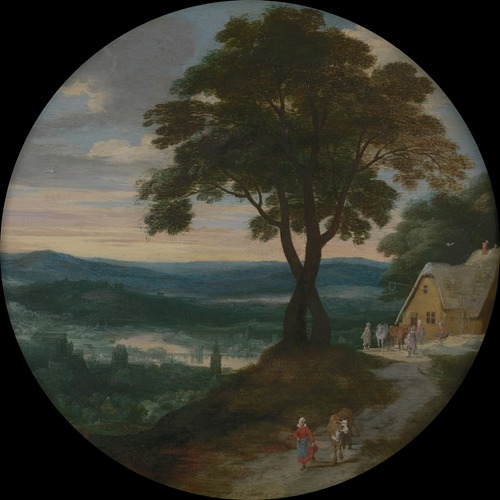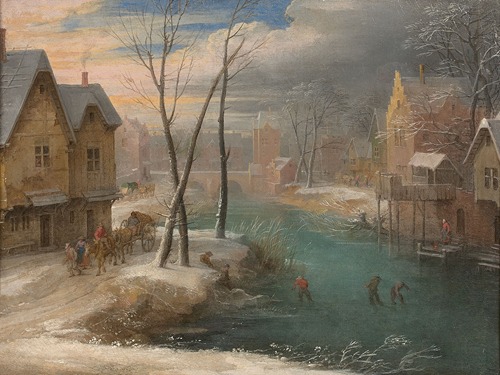

Jacques Fouquier, Jacques Fouquières or Jacob Focquier was a Flemish landscape painter. After training in Antwerp he worked in various places where he often obtained appointments as a painter to the court including that of the French kings. He earned great success and a very high reputation during his lifetime and was even referred to as the 'Flemish Titian'. Very few of his paintings have been preserved. His work was influential in his time and was widely circulated thanks to reproductions by various contemporary engravers.
Little is known with certainty about the life of Jacques Fouquier. He was traditionally believed to have been born in Antwerp at about 1580. Wolfgang Stechow was able to show in 1930 that his birth date should be placed around 1590. He came to this conclusion on the basis of an autograph inscription by Fouquier on a drawing dated 1604 kept in the Art Collection of the University of Göttingen (inv. no. H 465). The drawing contains in the lower right corner the inscription I.F. jaques foucquier me feciet aetatis suae 13 iaer 1604 5 ianvarer ('I.F Jacques Foucquier made me at the age of 13 in the year 1604 on 5 January. There is no documentary evidence to prove his place of birth. The 17th century German Baroque art-historian Joachim von Sandrart stated that Fouquier was the scion of a good family from western Flanders. A signature on an early drawing after Jan Brueghel the Elder indicates that he used the French name at an early age which possibly suggests that his ancestry was a French-speaking community.
In 1614 he was registered as a master painter under the name Jacques Foucque in the registers of the Antwerp Guild of St. Luke. The record does not mention who was his master. Some art historians have proposed a traineeship first under Joos de Momper, a prominent landscape painter and later under Jan Brueghel the Elder, a prolific painter and regular collaborator of Rubens. While there is no documentary evidence for such apprenticeships, they are supported on stylistic grounds. Although some biographers believe he left Antwerp shortly after 1614, others claim he is still mentioned in Antwerp as late as 1616. He was possibly registered in the Brussels' Guild of Saint Luke in 1616 as a pupil of Arnould van Laken and became citizen of the city of Brussels in the same year.
In the period between 1616 and 1619 he worked in Heidelberg at the court of the art loving Frederick V, the Elector Palatine. He was in charge of the decorative programme for the new 'Englischer Bau' (English building) of Heidelberg Castle, which was purpose-built for the Elector's English bride Elizabeth Stuart. He also painted a View of the Hortus Palatinus and Heidelberg Castle during this time (before 1620, (Kurpfälzisches Museum, Heidelberg). From 1619 to 1621 he was back in Brussels, where Philippe de Champaigne was one of his pupils. He possibly travelled around 1620 to Italy where he resided for a time in Rome.
At the latest by 1621 he had established himself in Paris, where he became court painter to King Louis XIII. The monarch elevated him to the peerage in 1626. This mark of distinction is said by Dezallier d'Argenville to have rendered him so vain, that afterwards he always painted with his sword on his side. On 15 July 1626 the king commissioned him to make plans, paintings and views of landscapes for the Grande Galerie of the Louvre palace. To execute this commission, Fouquier travelled to Toulon in 1626, Aix-en-Provence in 1627, Toulon and Marseille in 1629 and Toulon and Aix-en-Provence in 1632 and Toulon in 1633. It seems he was a slow (or even lazy) painter as only in 1632 the citizens of Toulon were able to send the first of his two large paintings to the King. Legend has it that this commission was the cause of a public rift between Foucquier and Nicolas Poussin in the summer of 1641. It was provoked by the exacting attitude of Foucquier vis-à-vis Poussin in relation to the decoration of the Grande Galerie of the Louvre palace. Foucquier insisted his landscapes be the principal decorations. In a letter to Paul Fréart de Chantelou, Poussin made fun of "le baron Foucquier" and is said to have avenged himself after his escape from Paris associated with the dispute in an allegory in which Foucquier was represented by a donkey on which Jacques Lemercier sat enthroned as the queen of stupidity.
Fouquier lived in 1644 together with Flemish artists Philippe Vleughels, Pieter van Mol, Willem Kalf, Nicasius Bernaerts and Peter van Boucle in Paris. He died at the end of 1655 in a room given to him by the painter Sylvain in the Fauxbourg Saint Jacques in Paris. The inventory of his estate was drawn up on 4 January 1656 at the behest of his creditors. His meager possessions are evidence that he had fallen on hard times at the end of his life.
His pupils included Philippe de Champaigne, Matthieu van Plattenberg, and Etienne Rendu.

